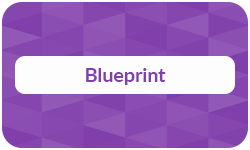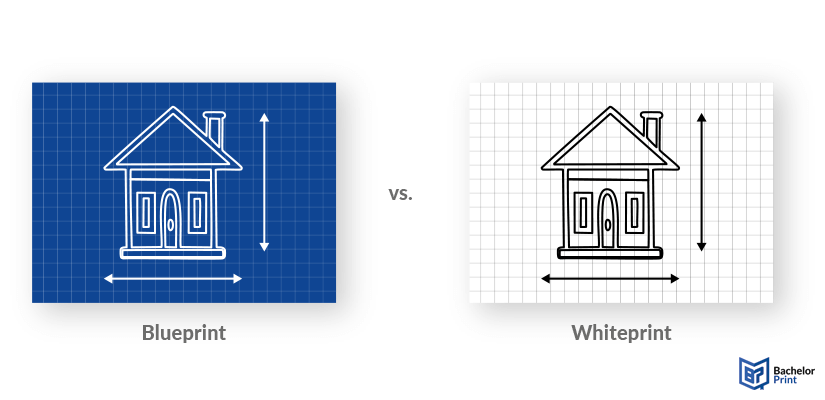
Whether in architecture, engineering, or design, the blueprint remains one of the most iconic printing terms. Originally used to reproduce technical drawings, it has since evolved from chemical processes to modern digital plotting. This article explains what a blueprint is, how it’s used today, and what you need to know when printing one.
Definition: Blueprint
A blueprint is a reproduction of a technical drawing, typically used in architecture, engineering, and manufacturing. In the context of printing, it refers to a large-format copy of a plan or schematic that displays precise measurements, line work, and annotations.
The term originates from a 19th-century photographic printing process called cyanotype. This blue-white contrast became so iconic that the term “blueprint” is still used today, even when the documents are printed in black and white.
History
The blueprint was invented in the mid-19th century by John Herschel, who developed the cyanotype process using light-sensitive ferric compounds. This method produced white lines on a blue background and quickly became the standard for reproducing architectural and engineering drawings.
For decades, it was a key tool in construction and manufacturing. Today, blueprints have largely been replaced by digital plotting and CAD-based printing, though the term remains in common use.

A3 printing for CAN$0.21 at BachelorPrint
- Quickly print your A3 papers online
- Choose from a variety of finishes & extras
- Vibrant A3 poster printing on premium paper
Learn more!
Blueprint printing
While rooted in historical chemical processes, blueprint printing today is largely digital, relying on modern plotters and file-based workflows for efficient and precise reproduction of technical drawings.
Traditional blueprinting
Traditional blueprinting relied on chemical processes like cyanotype, where UV light and photosensitive paper were used to develop white lines on a blue background. This method was time-consuming and required manual processing.
Modern blueprinting
Modern blueprinting uses digital files and large-format printers to produce high-resolution technical drawings quickly. These can handle scalable vector formats, allowing for faster, cleaner, and more flexible output (in black and white or grayscale).
In today’s architectural and engineering environments, large-format inkjet and laser plotters are standard. These machines can print large-format technical drawings with exceptional detail and accuracy, supporting various standard sizes used worldwide. CAD-based designs are fed directly to the plotter, which ensures:
- Precise scaling
- Fine line reproduction
- Reliable monochrome output
Blueprint vs. whiteprint
While the traditional blueprint uses a blue background with white lines, the whiteprint, also known as the diazo print, reversed this format and became the standard in many industries due to its improved readability and ease of reproduction.
| Blueprint | Whiteprint | |
| Color scheme | White lines on a blue background | Blue or black lines on a white background |
| Process type | Cyanotype (UV + ferric salts) | Diazo chemical process |
| Readability | Lower contrast, harder to annotate | Higher contrast, easier to copy/mark |
| Usage period | 19th to mid-20th century | Mid-20th century onward |
| Relevance | Mostly historical or decorative use | Still used in some analogue workflows |
Note: Today, the term “blueprint” is often used generically, but most printed plans are technically whiteprints produced by digital means.

Uses
Blueprints are widely used across industries and private settings, whether for planning large-scale construction projects, documenting technical systems, or reproducing designs for educational or decorative purposes.
B2B
Blueprints continue to play a key role in many technical and professional fields:
Blueprints are essential for visualizing and communicating the design, structure, and layout of buildings. They ensure that all stakeholders, from architects to contractors, are working from the same detailed plan.
Engineers use blueprints to document complex systems, components, and circuits with exact specifications. These drawings serve as a reference throughout the design, testing, and manufacturing process.
Blueprints are often legally required for submitting construction or renovation plans to regulatory authorities. They provide standardized, scalable documentation of intended works.
B2C
Outside the professional sphere, blueprints are also relevant for private or creative use:
Old blueprints are frequently digitized or reprinted for decorative or archival purposes. Their aesthetic appeal and historical value make them popular in creative contexts.
Students, hobbyists, and makers use blueprints to visualize and present projects clearly and professionally, especially in architecture, design, or engineering studies.
Format, paper & requirements
To ensure accurate and professional results when printing blueprints, certain technical standards must be met. These relate to format, printer paper type, plotting quality, and file specifications.
Blueprints are typically printed in large ISO formats, depending on the level of detail required:
- A2: Suitable for small-scale plans or sections
- A1: Common for architectural and engineering drawings
- A0: Used for comprehensive or highly detailed projects
The paper needs to be lightweight yet durable, allowing for clean line reproduction and easy handling:
- White bond paper (standard for most modern prints)
- Translucent paper (used for overlays or archival purposes)
Most blueprint prints feature:
- Black or blue lines on a white background
- Monochrome or grayscale printing, depending on file type
- High print resolution (typically 300–600 DPI for fine line precision)
For accurate plotting, files must be properly formatted and scaled:
- PDF: Most common and universal for print-ready documents
- DXF: Interchange format for sharing CAD data across platforms
- DWG: CAD drawing format used by AutoCAD and similar software
Advantages & disadvantages
Blueprint printing remains a practical solution for technical documentation, but it comes with both strengths and limitations depending on the use case.
Advantages
- Standardized formats for professional use
- Cost-effective for large-scale plan printing
- Precise reproduction of technical drawings
Disadvantages
- Bulky and prone to damage
- Unsuitable for color or photo prints
- Requires large-format printers or plotters
Print black & white copies online for CAN$0.14
- Print black & white copies in bulk or in small quantities
- Affordable single- & double-sided black and white copies
- Professional printing service for individual solutions or printouts
Learn more!
Alternatives
While traditional blueprints have historical value, several modern alternatives offer greater efficiency, precision, and digital compatibility:

CAD plotting and digital large-format printing
Modern CAD plotting enables fast and accurate output directly from digital design files. Large-format printers can produce high-resolution technical drawings without the need for chemical processing.

Diazo & LED printing systems
Diazo printers (whiteprints) are still used in some analogue workflows. Newer LED systems offer faster output and improved energy efficiency, making them suitable for high-volume, monochrome plan printing.

Document management & digital archiving
Instead of printing, technical drawings can be digitally archived and shared as secure PDFs or cloud-stored CAD files. This supports collaboration, version control, and long-term project documentation.
FAQs
A blueprint is a traditional reproduction of technical drawings, originally using a chemical process that produced white lines on a blue background.
The name comes from the original cyanotype method. Even though modern prints are often black on white, the term blueprint is still commonly used to describe detailed technical plans.
Yes. Even in digital environments, blueprint is used informally to describe architectural or engineering drawings, regardless of how they’re printed or displayed.
A blueprint is a specific reproduction format for a plan. A plan refers to the drawing or design itself, while a blueprint traditionally referred to the physical print of that design.
Yes. Blueprint is often used metaphorically to describe any detailed plan or structured strategy, well beyond its original meaning in printing or design.